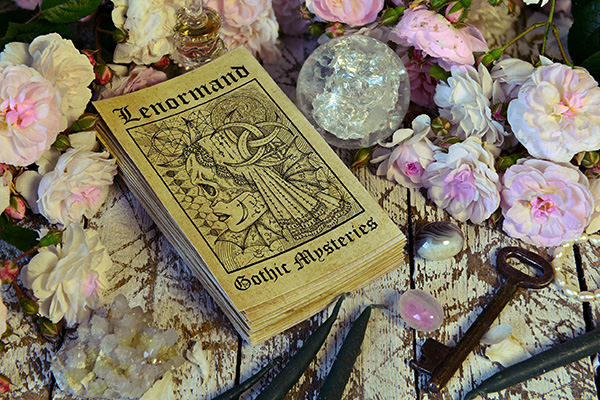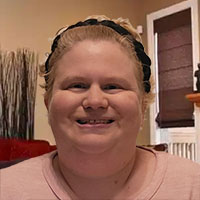Lenormand Cards Illuminate The Everyday
 A few years ago, I met a fellow psychic online who recommended that I add Lenormand cards to my divination repertoire. It is a decision I will always cherish, as learning these cards has certainly benefited both my spiritual and professional journey.
A few years ago, I met a fellow psychic online who recommended that I add Lenormand cards to my divination repertoire. It is a decision I will always cherish, as learning these cards has certainly benefited both my spiritual and professional journey.
Like Tarot, it is a card-based divination system rich in symbolism, but it is simpler than Tarot, with fewer cards in the deck, and easier to learn. Lenormand has only thirty-six cards instead of the bulkier 78-card Tarot deck.
This system of cartomancy is named after Marie Anne Lenormand (1772-1843), a famous French fortune teller of the Napoleonic era who was known for her work with influential figures of her time, although she did not create the cards herself. Lenormand cards became popular in the 19th century and have seen a resurgence of interest in recent years.
I use two types of Lenormand decks in my readings. One is the Petite deck and the other is the Dondorf Lenormand.
The design of the Petite Lenormand deck is simpler and more direct than that of the Dondorf Lenormand, focusing on clear, easily recognizable symbols without extensive ornamentation. This simplicity is intended to facilitate the interpretation of the cards, as the symbols and their combinations are the primary means of divination. The cards are also smaller than typical tarot cards and are modeled directly after the types of decks that Ms. Lenormand herself might have used or recognized.
The Lenormand cards provide another way of peeking into the winding palace of one’s own mind – helping you plot out possible courses and actions that you can take ~ Tina Gong
The Dondorf Lenormand is a deck originally produced by Bernard Dondorf, a German publisher of luxury playing cards based in Frankfurt, Germany. The Dondorf Lenormand is known for its intricate and elaborate artistic design. It features elaborate borders, rich coloring, and detailed imagery that reflect the aesthetic preferences of the Victorian era and the lithographic style popular in the late 1800s. The Dondorf version became the most important Lenormand pack of the 19th century.
The choice between Dondorf Lenormand and Petite Lenormand decks often comes down to personal preference regarding the artwork, the size of the cards, and the historical context that each user finds most appealing or resonant. Both types of decks are used for the same type of cartomancy, and the effectiveness of the reading depends more on the skill and intuition of the reader than on the specific deck chosen.
LENORMAND VS. TAROT
The Lenormand deck is distinct from the Tarot and other oracle cards in both its structure and the method of interpretation. Each card in a Lenormand deck represents a specific symbol or object, such as a tree, a ship, or a heart, and readings are done by analyzing the cards in combination rather than in isolation. This creates a nuanced and detailed narrative that is interpreted based on the querent’s questions or life situation.
Unlike Tarot, which tends to delve into deeper psychological or spiritual themes, Lenormand readings are typically more straightforward and direct, offering clear and actionable guidance. Here’s a breakdown of the key differences between Lenormand and Tarot:
DECK STRUCTURE
The Lenormand deck consists of 36 cards, each depicting a specific symbol or object (such as a tree, a ship, or a heart). The cards are read in combinations, and the meanings are more literal and straightforward.
The Tarot deck has 78 cards divided into two main sections: the Major Arcana (22 cards) and the Minor Arcana (56 cards). The Major Arcana cards represent significant life themes and lessons, while the Minor Arcana cards, further divided into four suits, deal with day-to-day issues. Tarot symbolism is rich and complex, often incorporating elements of mythology, astrology, and esoteric traditions.
SYMBOLISM & INTERPRETATION
The symbols on Lenormand cards are everyday objects and situations, making their meanings more literal and easier to understand at face value. The art of reading Lenormand lies in combining these symbols to create detailed and specific messages.
Tarot cards are filled with symbolic imagery that can have multiple layers of meaning. Interpretation requires a deep understanding of these symbols, and readings can be highly subjective and open to the reader’s intuition and personal insights.
READING STYLE
Lenormand readings focus on practical matters and provide clear, concise answers. The cards are interpreted based on how they interact with each other in a spread, creating a narrative that directly addresses the querent’s situation.
Tarot readings can explore psychological, spiritual, and material aspects of a person’s life, offering insights that are interpretative and reflective. The meanings of the cards can vary significantly depending on their position in a spread, the question asked, and the reader’s intuition.
READING THEMES
Lenormand readings are generally more focused on specific questions and concrete outcomes. They are particularly well-suited for looking at the dynamics of situations, predicting future outcomes, and offering practical advice.
Tarot can address specific questions but is often used for broader inquiries about personal growth, spiritual development, and understanding underlying motives and influences. Tarot readings can offer guidance, highlight underlying issues, and suggest potential courses of action rather than predict specific outcomes.
I believe in the power of the cards to illuminate what you already know and to awaken the wisdom inside of you. I believe in the magic of the cards to inspire us to let go of old ideas and restrictions ~ Tonya Sheridan
COMBINING LENORMAND AND TAROT
Traditionally the Lenormand is read based on the positioning of the cards in addition to the symbolic meanings. For example, the left side of a spread often represents the past, while the card on the far right represents the future outcome. In a larger spread like the Grand Tableau, where all 36 cards are arranged in four rows of eight and a fifth row of four, the positioning of the cards above and below each other also takes on meaning and significance.
However I read the Lenormand differently than the traditional practice. I read them like the Tarot, interpreting them in upright and inverted positions. I find that by blending Lenormand’s straightforward symbolism with the narrative depth and intuitive exploration characteristic of Tarot style readings, one can create a rich, insightful experience that bridges the gap between the practical and the spiritual.
Reading Lenormand cards like the Tarot involves adapting the approach to focus more on the narrative and intuitive aspects of the reading, while still respecting the unique characteristics of the Lenormand system. Here’s how you can adapt your Lenormand readings to incorporate some of the depth and introspection typically found in Tarot readings:
NARRATIVE FLOW
Unlike Tarot, where individual card meanings can stand alone, Lenormand readings rely heavily on the story that unfolds through the combination of the cards. Think of your reading as a story or a conversation, where each card contributes to a narrative. This approach requires a flexible mindset that allows the symbols on the cards to interact with each other in a way that creates a cohesive story relevant to the querent’s situation.
LARGER SPREADS
While Tarot readings range from single card draws to complex spreads like the Celtic Cross, Lenormand readings are known for the Grand Tableau, which uses all 36 cards. This spread provides a comprehensive view of the querent’s life, similar to the detailed insights offered by larger Tarot spreads. By examining the interactions between cards in close proximity and the way certain themes emerge throughout the spread, you can offer insights that touch on various aspects of the querent’s life, from personal growth to external influences.
SYMBOLISM
Like Tarot, Lenormand has “positive” and “negative” cards. For example, The Rider is the first card in the deck and often symbolizes communication or a message that is about to come. However, if it is placed next to the Scythe, you should know that this message will require a lot of hard work. The Scythe is similar to the 10 of Wands in Tarot in that it carries a heavy burden that can cause great danger and risk if not carried carefully.
There is also a Tower card in Lenormand, but this Tower is very different from the Tarot Tower. It typically represents a time of seclusion or reflection, but if done to excess, it can also bring excessive isolation or even more significant consequences, such as death from loneliness. The Clouds, number 6 in Lenormand, is a card of confusion and primarily represents this type of toxic isolation when combined with the Lenormand Tower.
Lenormand cards like the Ring, Heart, Bouquet and Clover are self-explanatory. They represent the good, happy and joyful times in life, such as proposals, unconditional self-love and happiness. When they appear in a reading, be prepared to enjoy your good news and celebrate all your hard work. You deserve it!
INTUITION
Although Lenormand symbols are more literal and straightforward than Tarot archetypes, integrating a level of intuitive interpretation and psychic perception adds depth. Consider the personal or collective symbolism of the objects depicted on the cards and how these symbols might speak to the querent’s subconscious or emotional state. This approach requires tapping into your intuition to see beyond the obvious meanings and explore the symbolic nuances, much like tarot readings.
DEEPER EXPLORATION
While Lenormand typically focuses on practical matters, you can use the cards to explore broader themes in the querent’s life by focusing on the emotional or psychological aspects of the symbols. For example, the Ship card might indicate not only travel, but also a journey of personal growth or a desire for change. This involves looking for underlying patterns or themes that emerge in the reading and relating them to the querent’s inner world.
Finally, you may wonder which is best: Lenormand or Tarot? Whether to use one or the other depends on the nature of the question, the type of insight sought, and personal preference. Some people may prefer Lenormand for its straightforwardness and practical advice, while others may be drawn to the depth, complexity, and spiritual guidance offered by Tarot readings. Many readers use both systems, depending on the context and needs of the querent.
|
|
This site uses Akismet to reduce spam. Learn how your comment data is processed.
- Joan on Reflections On Time…And The Timeless
- Ma8 on Reflections On Time…And The Timeless
- Flowers name in Hindi on The Mystical Secrets Of Flowers
- Pam on How To Connect With Your Guardian Angel
- astrosaiganesh on How To Navigate The Sun’s Debilitation In Libra
- mahendar on What Happens To Our Pets When They Cross Over
- Megan Gutleben on How To Maintain A High Vibe Every Day
- spiritual healing on The True Role Of The Spiritual Healer
- Mballe on Why Some Souls Depart This Life Early
- Elizabeth Ocskay on The Mystery Of Soul Groups And Soul Contracts
- Christopher Guleff on The Mystical Purpose Of Daydreaming
- devanand astrologer on Psychic Messages In Mediumship Readings
- Linda Deir on Our Pets Speak To Us In This Life And Beyond
- Veronica on Why Some Souls Depart This Life Early
- astrologer devanand on Chakra Balancing Is An Essential Self-Care Practice
- Kirti on How To Deal With Negativity And Toxic Drama
- psychicramdev on How To Navigate The Sun’s Debilitation In Libra
- Grace on The Psychic Technique Of Remote Viewing
- Pam on Energy Protection 101
- Jo on The Principles Of Ethical Psychic Reading

Leave a Reply